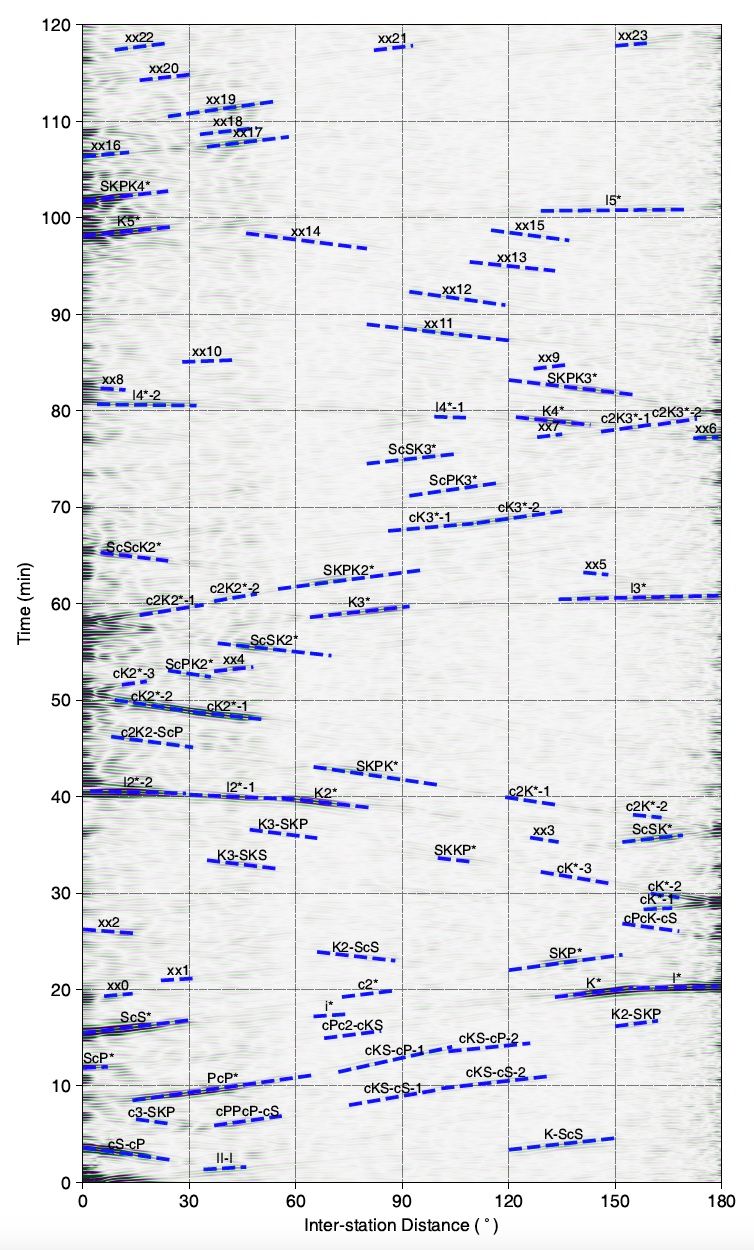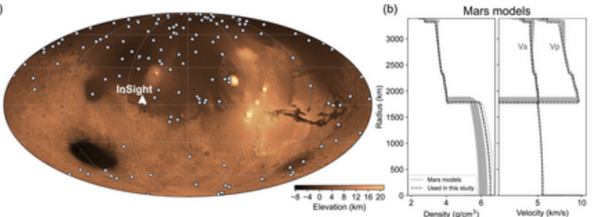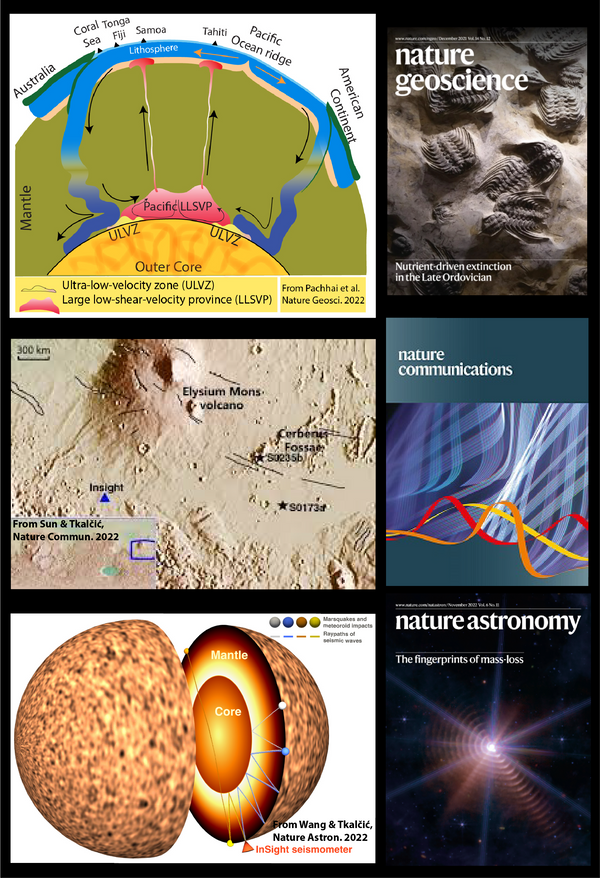New Reference Earth Model: CCREM
Image credit: CLAUS LUNAU / SCIENCE PHOTO LIBRARY: https://www.sciencephoto.com/
Seriously? Why do we need a new reference Earth model?
Unlike fashion models, who have stylists and artists crafting their appearance, geophysicists construct structural models of the Earth by using mathematical tools, observations and simulations of seismic waves propagating through the Earth's interior, from its surface to the core. In these one-dimensional (1D) models, the Earth (or, as a matter of fact, any other planet) is divided into kilometres thick spherical layers, just like an onion on a much smaller scale. In these layers, the quantities such as density, gravity, or the speed of seismic waves, are given in terms of their spherical averages, i.e. they do not vary laterally, and we refer to such models as spherically symmetric. Geophysicists and astronomers have been using them as the points of reference for physical properties along planetary radii. But, seriously, do we need new reference Earth models?

You might be surprised to learn that the most widely used 1D Earth (reference) models were derived and published in the eighties and nineties of the last century and haven't changed much since. For example, PREM (the Preliminary Reference Earth Model; Dziewoński and Anderson, 1981) was constructed from the observations of long-period waves (on the order of hundreds of seconds), while iaspei91 (International Association of Seismology and Physics of the Earth's Interior; Kennett and Engdahl, 1991) and ak135 (Kennett et al., 1995) are the models constructed from the observations of relatively short-period seismic waves (on the order of 1 second). These models have been proven to provide reasonably good predictions of seismic observations; for example, by using one such model, one can predict the travel times of seismic waves from an earthquake focus to a seismic station on the other side of the globe within a second accuracy. However, there are still poorly constrained depths. This is especially true near the main internal boundaries, such as the solid inner-liquid outer core boundary or the core-mantle boundary, where the vigorously convecting liquid core meets the slowly convecting, rocky mantle.
If not taken into account, these fine details of Earth structure near its internal boundaries make considerably less accurate wave propagation predictions – one of the main reasons for working on a new Reference Earth Model. Why are these accurate predictions important? Well, if you want to predict travel times or wave shapes to locate an earthquake and determine the precise time it occurred, you must have an accurate structural model. If you want to detect a clandestine nuclear explosion, you better possess an accurate model. Say you want to perform a 3D seismic imaging using tomography and need a starting point, you should arm yourself with a reference model, which you will use to describe volumetric perturbations from some initial structure. If you are an astronomer, you will want to have details of the internal planetary structure to understand how they formed, to compare it with their shape, gravity and rotation. For example, for a given spin rate, the terrestrial planets will flatten less when more mass is in the centre, so assuming a similar composition to the Earth's silicates and iron, one can derive the core size.
So, let us demystify the name behind our new model first. CCREM stands for Coda-Correlation Reference Earth Model. The word coda in seismology has the same use as in music – it refers to the last parts of seismic recordings, in this case, the Earth's aria hours after the earthquake's occurrence.
This is the time when primary body waves released in a large quake have already rippled through the crust, mantle and core, and the surface waves have circumnavigated the Earth's surface, even multiple times. Some waves bounced back from the interior and retained their strength on the recordings, but most of the seismic-wave energy already have dissipated within the Earth's volume through the processes of absorption and scattering. It is in these late and weakened wiggles that we find the beauty of similarity through a mathematical operation called correlation. That's right; the correlation is simply a way to measure the similarity of tiny recorded wiggles that were once waves bouncing off and penetrating through the Earth's internal boundaries. Measuring their similarity becomes even a more powerful tool than measuring the waveforms themselves. So, one could say it is the similarity that Xiaolong Ma and I use to construct the new reference model of the Earth.
Fast forward many months of flexing the muscles of Australia's largest supercomputer – Gadi and those of our own Terrawulf, and here we are, with CCREM ready to be used, challenged by scientists and judged by the passage of time. A subtle difference between CCREM and previous models is that it is "sensitive", by virtue of its seismological probe, to the wave periods in the intermediate range, 15-50 seconds, just between PREM’s and ak135’s sensitivity. CCREM is a valuable and interesting model companion precisely in these subtleties: the structures it finds could shed new light on Earth's physical and chemical properties, mineral compositions, and dynamic processes.
References
The CCREM paper has just been published in the Journal of Geophysical Research – Solid Earth, and for those who would like to know more, here is a link to it:
Ma, X., & Tkalčić, H. (2021). CCREM: New reference Earth model from the global coda‐correlation wavefield. Journal of Geophysical Research: Solid Earth. https://doi.org/10/gmmrn6
Kennett, B. L. N., & Engdahl, E. R. (1991). Traveltimes for global earthquake location and phase identification. Geophysical Journal International, 105(2), 429-465. https://doi.org/10.1111/j.1365-246x.1991.tb06724.x
Kennett, B. L. N., Engdahl, E. R., & Buland, R. (1995). Constraints on seismic velocities in the Earth from traveltimes. Geophysical Journal International, 122(1), 108-124. https://doi.org/10.1111/j.1365-246x.1995.tb03540.x
Dziewoński, A. M., & Anderson, D. L. (1981). Preliminary reference Earth model. Physics of the Earth and Planetary Interiors, 25(4), 297-356.
https://doi.org/10.1016/0031-9201(81)90046-7
Editor: Louis Moresi
Updated Aug 29, 2021 with additional references.



